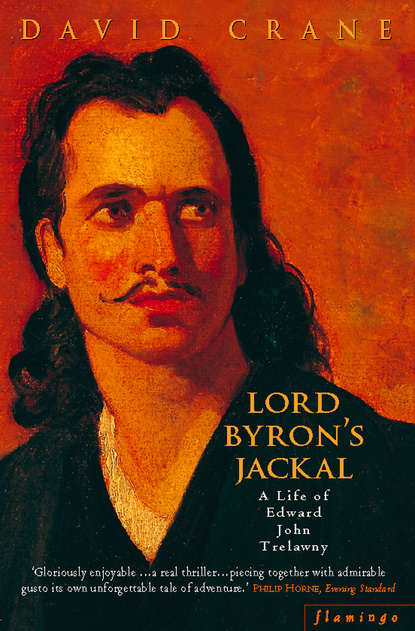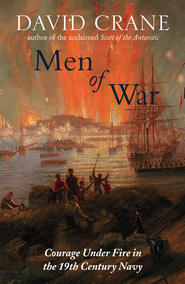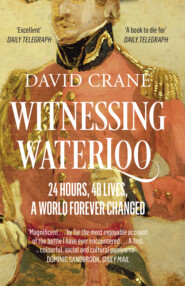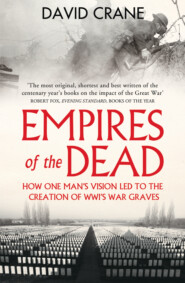По всем вопросам обращайтесь на: info@litportal.ru
(©) 2003-2024.
✖
Lord Byron’s Jackal: A Life of Trelawny
Настройки чтения
Размер шрифта
Высота строк
Поля
(#litres_trial_promo)
Byron, however, was going to need more than charm to survive the months ahead as their brief stop in Leghorn underlined. While the Hercules was still in the roads, he wrote a final letter to Bowring, the Secretary of the London Greek Committee to which he had been elected, striking in it a note that can be heard again and again in his subsequent letters from Greece. ‘I find the Greeks here somewhat divided amongst themselves’, he reported,
I have spoken to them about the delay of intelligence for the Committee’s regulation – and they have promised to be more punctual. The Archbishop is at Pisa – but has sent me several letters etc. for Greece. – What they most seem to want or desire is – Money – Money – Money … As the Committee has not favoured me with any specific instructions as to any line of conduct they might think it well for me to pursue – I of course have to suppose that I am left to my own discretion. If at any future period – I can be useful – I am willing to be so as heretofore. –
(#litres_trial_promo)
The punctuation of Byron’s letters invariably gives a strong sense of rapidity and urgency of thought, an immediacy that makes him one of the great letter writers in the language, and yet curiously here it only serves to reinforce a sense of uncertainty and drift. It is a feeling that seems mirrored in the mood on the Hercules as each day put his Italian life farther behind him. There is an air of unreality about this journey, as if the Hercules and its passengers were somehow suspended between the contending demands of past and future, divorced from both in the calm seas that blessed the next weeks of their passage. It is hard to believe that, for all his clear-eyed and tolerant realism about the Greeks, Byron had any real sense of what lay ahead. The memory of Shelley’s corpse on the beach could quicken his natural fatalism into something like panic at the thought of pain but even this was a passing mood. As Trelawny later recalled, he had never travelled on ship with a better companion. The weather, after they left Leghorn, was beautiful and the Hercules seldom out of sight of land. Elba, the recent scene of Napoleon’s first exile, was passed off the starboard bow with suitable moralizings. At the mouth of the Tiber the ship’s company strained in vain for a glimpse of the city where Trelawny had buried Shelley’s ashes and prepared his own grave. During the day Byron and Trelawny would box and swim together, measure their waistlines or practise on the poop with pistols, shooting the protruding heads off ducks suspended in cages from the mainyard. At night Byron might read from Swift or sit and watch Stromboli shrouded in smoke and promise another canto of ‘Childe Harold’.
And yet Byron, if he ever had been, was no longer the ‘Childe’ and in that simple truth lay a world of future misunderstandings. One of the most moving aspects of his last year is the way his letters and actions reveal a gradual firming of purpose, a steady discarding of the conceits and fripperies of his Italian existence, a unifying of personality, an alignment at last of intelligence and sensibility – a growth into a human greatness which mirrors the development of his literary talents from the emotional and psychological crudity of ‘Childe Harold’ into the mature genius of ‘Don Juan’.
For anyone interested in poetry it is in that last masterpiece that the real Byron is to be found, but it was not the Byron that Trelawny had come to Italy in search of. Even before the Hercules had left Leghorn he was airing his reservations in letters to Roberts and Claire, but the fact is that his unease in Byron’s company was as long as their friendship itself. Eighteen months earlier, in January 1822, Trelawny had come looking for Childe Harold and found instead a middle-aged and worldly realist. He had come to worship and found a deity cynically sceptical of his own cult. ‘I had come prepared to see a solemn mystery,’ he wrote of their first meeting in the Palazzo Lanfranchi, ‘and so far as I could judge from the first act it seemed to me very like a solemn farce.’
(#litres_trial_promo)
One of the great truisms of Romantic history is that Byron was never ‘Byronic’ enough for his admirers but this failure to live up to expectations seems to have constituted a more personal betrayal for Trelawny than it did for other acolytes. In trying to explain this there is a danger of ignoring the vast intellectual gap which separated the two men, yet nevertheless something is needed to account for the resentment which, even as they set off together, he was stoking up against Byron. Partly, of course, it was the bitterness of the disappointed disciple, but there was something more than that, something which Romantic myth and twentieth-century psychology in their different ways both demand to be recognized – the rage of the creature scorned in the language of one, of childhood rejection in the more prosaic terminology of the other.
The moment words are put to it they seem overblown and lame by turns but it is impossible to ignore the evidence of a lifetime’s anger. No iconoclast ever had such a capacity for hero-worship as Trelawny and, of the long string of real or imagined figures who filled the emotional vacuum of a loveless childhood, Byron was the earliest and the greatest. In among the fantasies that Trelawny published as his Adventures, there is a description of his first meeting with the mythical De Ruyter, the imagined archetype and amalgam of all Trelawny’s heroes. It gives a vivid insight into what he had sought in Byron when he first came to Italy. ‘He became my model,’ he wrote,
The height of my ambition was to imitate him, even in his defects. My emulation was awakened. For the first time I was impressed with the superiority of a human being. To keep an equality with him was unattainable. In every trifling action he evinced a manner so offhand, free, and noble, that it looked as if it sprung new and fresh from his own individuality; and everything else shrunk into an apish imitation.
(#litres_trial_promo)
This kind of hero, however, was not a role that the thirty-five-year old Byron, with his anxieties over his weight or the thickness of his wrists, had either the inclination or temperament to fill. The helmets and uniforms in his luggage are reminders that, even in his last year, the exhibitionist in him was never entirely stilled, but the irony and self-mockery with which he treated himself in his poetry was now equally, if humorously, turned on his ‘corsair’. Trelawny, he memorably remarked, could not tell the truth even to save himself. In another variant on this he suggested that they might yet make a gentleman of him if they could only get him to tell the truth and wash his hands.
For a man who was probably only too familiar with Trelawny’s battle against his father’s pet raven, this was a dangerously cavalier attitude to take to the child of his poetic imagination. ‘The Creator’, as Claire had warned Byron in her first letter to him before they met, ‘ought not to destroy his Creature.’
(#litres_trial_promo) For a man, also, who in Pisan lore had been responsible for the death of Claire’s Allegra, this was doubly true. Byron was too careless, however, to see the trouble he was laying down. On board the Hercules a mixture of his own tolerance and Trelawny’s presumption kept relationships cordial, but it was a deceptive calm. ‘Lord B. and myself are extraordinarily thick,’ Trelawny wrote edgily to his friend Roberts in a letter from Leghorn.
We are inseparable. But mind, this does not flatter me. He has known me long enough to know the sacrifices I make in devoting myself to serve him. This is new to him, who is surrounded by mercenaries. I am no expense to him, fight my own way, lay in my own stock, etc … Lord B. indeed does everything as far as I wish him.’
(#litres_trial_promo)
It was a sad delusion but it was enough to preserve the peace of the voyage. At the toe of Italy the Hercules turned east, through the Messina Straits and towards Greece. Their first destination was the port of Argostoli on Cephalonia, one of the Ionian Isles under British control. As they passed through the untroubled waters between Scylla and Charybdis, Byron complained of the tameness of life. His boredom was premature. His and Trelawny’s lives were moving to their distinct but inseparable crises. ‘Where’, Byron had mused at Leghorn, ‘shall we be in a year?’ It afterwards seemed to Pietro Gamba, Teresa Guiccoli’s brother, ‘a melancholy foreboding; for on the same day of the same month, in the next year, he was carried to the tomb of his ancestors.’
(#litres_trial_promo) On 2 August 1823, the Hercules entered the approaches to Argostoli. Byron had just nine months to live: Trelawny, nearly sixty years to vent his feelings against the man who had first created and then wearied of him.
3 ET IN ARCADIA EGO (#ulink_22467bf4-93c8-551d-a9fd-c0e7530aef33)
‘And without ties – wearied and wretched – melancholy and dissatisfied – what was left me here? – I have been dying piecemeal – thin – careworn – and desponding – Such an excitement as this was necessary to rouse me into energy and life – and it has done so – I am all on fire for action – and ready to endure the worst that may befall, seeking nothing but honour.’
Trelawny to Claire Clairmont 22 July 1823
(#litres_trial_promo)
TEN DAYS AFTER THE Hercules anchored off the port of Argostoli, a small group from the ship lay picnicking beside the Fountain of Arethusa on the Homeric isle of Ithaca. Beneath them the water from the spring tumbled away into a dark ravine. ‘The view,’ Hamilton Browne, the young Philhellene who had joined them at Leghorn, recalled ten years later,
embracing the vast sea-prospect, the Aechirades, the entrance to the Gulf of Corinth, or Lepanto, with the distant purple mountains of Epirus and Aetolia, lifting their lofty peaks into the clouds, was superb; and ascending the hill at the back of the cavern, Santa Maura, the ancient Leucadia, with its dependencies, was distinctly descried, together with Cephalonia, apparently close at hand; Zante, and the coast of the Peloponessus, trending far away to the southeast. A more lovely situation could scarcely be imagined.
(#litres_trial_promo)
It would be difficult also to imagine a view more completely at odds with reality. If one could have followed Browne’s panoramic sweep across the map of western and southern Greece, only seen it shorn of that seductive allure which distance and classical associations gave it for him – if one could have extended that view further, beyond the ruined city of Tripolis to Nauplia and Argos in the east, and beyond those again as far northwards as Salonica or south to Crete and Cyprus: or, again, if one shortened that perspective, to take in the emaciated figures crowding the little port of Vathi hidden at the picnickers’ feet, refugees from the ruins of Patras and the horrors of Chios, then wherever one looked the wasted faces of survivors or the whitening bones which littered the Greek landscape in their thousands would all have told the same story of a war of unimaginable brutality.
The conflict that had so devastated Greece had begun just over two years earlier in the spring of 1821. On 6 March, a Russian general of Greek extraction had crossed the River Pruth from Bessarabia into what is now modern Romania, raised his banner of the phoenix and called on the Christian populations of the Ottoman empire to throw off their oppressors.
Political realism has never been a feature of modern Greek history but, even by the extravagances of the last century and a half, Moldavia was a curious place to start a revolution. For almost four hundred years the Trans-Danubian provinces of Moldavia and Wallachia had suffered the heavy burden of Ottoman rule, and yet at the end of all that time, if there was a single sentiment beyond a hatred of the Turks that might have united its disparate peoples, it was a loathing of the Greek that ran almost as deep. For nearly four centuries Greeks had worked within the Ottoman Empire as assiduously as they had within its Roman predecessor, their women stocking its harems and their children its armies, their merchants, sailors, translators and administrators garnering to themselves those tasks and powers that seemed below Moslem dignity, and their great Constantinople families – the Greeks of the Phanar on the southern shore of the Golden Horn – sending out generation after generation to govern in the Danubian provinces with a greed that comfortably eclipsed that of their masters.
It was one of the great tragedies of the War of Independence that the melancholy condition of Greece itself meant that its leadership inevitably fell to these Greeks of the Phanar and the scattered communities which made up the world of the Greek diaspora. Since the last, magical flowering of Byzantine culture at Mystra in the fifteenth century the geographical area of Modern Greece had declined into a state of impoverished misery, an almost forgotten backwater of Ottoman Europe, its traditions of freedom wilted to the bandit culture of the mountain klephts and all memory of its unique artistic and political inheritance buried under centuries of oppression.
It was from the West that this memory, so vital and so hazardous to the regeneration of the country, was re-imported into Greece, but it was crucially among the educated communities of the diaspora that the first Greek converts were made. Throughout the eighteenth century, these colonies had grown and prospered in capitals and ports from Marseilles to Calcutta, and as this new pride in their ancient past seeped into their consciousness, western Hellenism underwent a crucial seachange that took it out of the study and into the realm of political ambition.
The result was a volatile and dangerous new faith which owed as much to the trading and cultural links of these colonies with the Phanariot world of Constantinople as it did to the architectural purism of Stuart and Revett. In the journals and paintings of European travellers and scholars, eighteenth-century Philhellenism largely remained an innocuous and literary phenomenon, but as it made its way back to the Greek communities of the Black Sea and southern Russia it became a heady mix of Hellenistic posturing and Byzantine nostalgia, of alien political theory and grandiose ambition that looked to Constantinople – simply but eloquently the ‘polis’ – as the centre of a new-born Greece.
With the spread of the ideas and language of revolution after 1789 and the increased trade of the Napoleonic years, these aspirations gained a momentum that not even the Congress of Vienna could halt. By 1820, revolution to most Greeks within and without the Ottoman Empire seemed inevitable. For the previous five years a secret society called the Philike Hetairia had been at work, proselytizing and fund raising within the thriving Greek communities of Europe and Russia, and recruiting among the clergy and leaders of the Peloponnese and Northern Greece.
In 1820, a year of revolution across Europe, with rebellions in Portugal, Spain, Italy, and crucially, Ali Pasha’s in Albania, the moment seemed at hand. Through the winter the Apostles of the Philike Hetairia moved through the islands and mainland of Greece, spreading the word from initiate to initiate to prepare for war. Secrecy was virtually abandoned, so certain was everyone of the approaching rebellion, so rightly confident of Turkish indolence. In the Peloponnese, Germanos, the Bishop of Patras, and Petro Bey Mavromichaelis, head of the Maniots in the southern mountains of ancient Sparta, made ready. From the Ionian Isles, the great bandit leader, Theodore Colocotrones, slipped back from exile onto the mainland, drawn by the irresistible lure of patriotism and plunder; and in a town in southern Russia, the committee of merchants who were the sole reality behind the Philike Hetairia’s shadowy ‘Grand Arch’ appointed Alexander Ypsilanti to its supreme command.
Perhaps nothing so typifies the limitations of the Hetairists as that choice, because if Moldavia was an improbable place to begin a Greek revolution then Alexander Ypsilanti was an even more unlikely candidate for leader. A major general in the Russian army and the son of a Moldavian Greek hospadar or prince, Ypsilanti seems to have brought little to his task beyond the arrogance of the court and the morals of an autocracy, his single, dubious qualification for command being an arm lost in battle.
Within days of crossing the Pruth and beginning his leisurely march south, the ‘steward of the stewards of the August Arch,’ as he styled himself in a piece of characteristic masonic flummery, had succeeded only in alienating the Christian population he had come to redeem. By June the revolution in the Danubian provinces was over before it had ever really begun, disowned by the Tsar and riven by jealousies, a casualty of the indecision and moral cowardice of its leader and the sheer fatuity of Greek ambitions.
Ypsilanti’s campaign and his own subsequent flight into Austria rank among the most disgraceful episodes of the whole war, and yet while the insurrection had failed in the Danubian provinces, it had taken hold in Greece itself. It had seemed inconceivable to conspirators there that the Philike Hetairia could enter Moldavia without the tacit support of the Tsar, and as they took stock of an Ottoman Empire frustrated from within by the conservatism of its military and religious leadership, threatened on its borders by their Russian co-religionists, its authority in Africa no more than nominal and its forces engaged in a war against its most powerful vassal in Albania, the expectations raised by the Society generated their own self-fulfilling momentum.
‘Bliss was it in that dawn to be alive,’ Wordsworth had once believed of the French Revolution, and few of Europe’s Philhellenes who now saluted the Greek insurrection in the same vein can have had any idea of the forces they had unleashed. For centuries Greek and Turk had lived together in close proximity and when fighting burst out in 1821 it was not between army and army, but between community and community, atrocity met by atrocity and massacre by massacre in a frenzy of racial and religious hatred that convulsed the whole of the Greek world.
Within months of Germanos declaring a Holy War at Ayia Lavra, twenty thousand Turks had disappeared in the Peloponnese, as Monemvassia, Navarino, Tripolis, and eventually Nauplia fell into Greek hands. On the island of Chios, eighteen thousand Greeks were slaughtered in a matter of days. At Athens, Constantinople, Nicosia, Smyrna, Saloniki, on Rhodes and Cos, Greek butchered Turk and Turk Greek until, finally, when ancient hatreds had been glutted, when there were no more Turks to burn, rape, baptize and slaughter in the Peloponnese, and no more Greeks to circumcise and kill on Chios; when two thousand women and children had been stripped and butchered in a pass outside Tripolis, and the eighty-year-old patriarch hanged outside his cathedral in Constantinople, the war settled down into a more conventional shape.
There are few conflicts before this century which so insistently demand to be remembered in terms of human misery, but if it is these horrors of 1821 that have left their most vivid mark on the national psyches of Greece and Turkey, it was the events of the next year that determined whether revolt would ever blossom into a full-scale war for independence. During the first months of rebellion Ottoman armies had been too busy with Ali Pasha of Ionnanina to deal with a second uprising as well, but with Ali’s murder on 5 February 1822 Sultan Mahmoud II, a ruler of slow and inexorable purpose, was at last free to turn his full attention to Greece itself.
The Ottoman plan was simple, and was embarked on with a characteristic confidence that took no account of terrain, season or opposition. From his base at Larissa in northern Greece the overall commander in Roumeli, Khurshid Pasha, sent two armies southwards down the western and eastern sides of the country, the first towards Misssolonghi and the other under the command of Dramali Pasha across the Isthmus of Corinth and into the Peloponnese and the heartland of the revolt.
With 23,000 men and 60,000 horses, Dramali’s army was the greatest to enter Greece in over a hundred years. Sweeping virtually unchallenged across the isthmus in July 1822, the Turks pushed down as far as Argos only to be reduced within a month by disease, privation, incompetence and unripened fruit to a dangerous and humiliating retreat through the unsecured mountain passes south of Corinth.
This retreat of Dramali’s weakened army gave the Greeks their greatest opportunity of the war in a terrain for which history, temperament and necessity had left them supremely well equipped. To the disgust of every foreigner reared on western tactics, their irregulars could never be made to stand up to Turkish cavalry in open conflict, but here among the crags and narrow mountain paths of Dervenakia it was another story, with those guerrilla skills honed by generations of brigand klephts coming spectacularly into their own.
With the Ottoman army trapped ‘like a herd of bisons’
(#litres_trial_promo) in the narrow passes, flight or defiance equally useless, Dervenakia was less a battle than a massacre. If the Greeks had not been more interested in plunder than killing, the slaughter would have been still worse, but even so five thousand Turks were killed and the army which had been sent to bring back ‘the ashes of the Peloponnese’ effectively destroyed. Ravaged by disease and hunger the remnant began their retreat along the southern coast of the Gulf of Corinth towards Patras, reduced first to horseflesh and then cannibalism, fighting among themselves over the graves of their comrades, burying their dead in the mornings only to dig them up again at night in a gruesome bid to ward off starvation.
Dervenakia gave the Greek army its most decisive victory of the whole war but just as important in its way was the campaign fought at the same time in western Greece. The army that had slaughtered the Turks in the passes of the north-east Peloponnese had fought under the most experienced of brigand chiefs in Theodore Colocotrones, but the force raised to face the Ottoman threat to Missolonghi was entrusted to the leadership of a newly arrived Phanariot aristocrat, Alexander Mavrocordato, a man for all his other talents without any experience of warfare and little enough of Greece itself.
The details of the campaign which followed belong properly to the military history of the rebellion, but the political and psychological impact of Mavrocordato’s failure are too important to ignore. The first task of this force was to relieve the Christian Suliote tribes of Epirus on the Turkish army’s right flank, and with this in mind Mavrocordato marched north from Missolonghi towards Arta with an army of a little over two thousand men, including in its ranks about one hundred Philhellene volunteers who had come out in the first months of the uprising.
The absurd vanity of many of these Philhellenes and the ingratitude of the Greeks they had come to save had already strained relations in Mavrocordato’s camp, and the first pitched battle they fought together confirmed the prejudices of both sides. Establishing his own headquarters at Langada on the eastern shore of the Ambracian Gulf, Mavrocordato pushed his army forward under the command of General Normann, his Chief of Staff. Advancing as far as Peta, a small village in the low hills to the east of the Turkish held town of Arta, Normann’s army prepared to face the enemy in a battle which could lose them everything and win them very little. In the van were their regular troops, comprising the Philhellene corps, and two battalions of Ionian volunteers and Greek soldiers. Behind them, holding the high ground and guarding their right flank, was a force of Greek irregulars led by an old and cynical bandit chief of dubious loyalty, Gogos.
Against the vastly superior force of infantry and cavalry that issued from Arta, the regulars held firm, their discipline and firepower repulsing the first Turkish assault without casualties. For the next two hours the battle seemed still to go their way, but while the Turkish commander, Reshid Pasha, kept up a desultory frontal attack on this force, a large contingent of his Albanian soldiers was marching in a flanking movement to the north in a bid to turn the Greek position.
With a strong body of Greek irregulars commanding the high ground, this should have been impossible, and the first that the Philhellenes knew of their fate was when they saw the Ottoman standard planted on the highest hill behind them. Gogos, in league with the enemy, had fled. The regulars were now hopelessly surrounded. Leading the cavalry himself, Reshid stormed their position, capturing their two pieces of artillery. Only twenty-five of the volunteers managed to force a way at bayonet point through the Turkish fines. The rest, fighting heroically to the end, redeemed every Philhellene folly by their courage, dying where they stood, or more horribly, on the walls of Arta.











